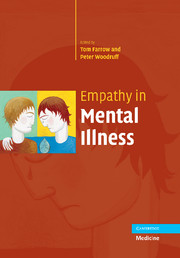Book contents
- Frontmatter
- Contents
- Foreword
- List of contributors
- Part I ‘Dysempathy’ in psychiatric samples
- Part II Empathy and related concepts in health
- 9 Neonatal antecedents for empathy
- 10 The evolutionary neurobiology, emergence and facilitation of empathy
- 11 Naturally occurring variability in state empathy
- 12 Neuroimaging of empathy
- 13 The neurophysiology of empathy
- 14 The cognitive neuropsychology of empathy
- 15 The genetics of empathy and its disorders
- 16 Empathogenic agents: their use, abuse, mechanism of action and addiction potential
- 17 Existential empathy: the intimacy of self and other
- 18 Empathizing and systemizing in males, females and autism: a test of the neural competition theory
- 19 Motivational-affective processing and the neural foundations of empathy
- 20 Face processing and empathy
- Part III Empathy models, regulation and measurement of empathy
- Index
11 - Naturally occurring variability in state empathy
from Part II - Empathy and related concepts in health
Published online by Cambridge University Press: 17 August 2009
- Frontmatter
- Contents
- Foreword
- List of contributors
- Part I ‘Dysempathy’ in psychiatric samples
- Part II Empathy and related concepts in health
- 9 Neonatal antecedents for empathy
- 10 The evolutionary neurobiology, emergence and facilitation of empathy
- 11 Naturally occurring variability in state empathy
- 12 Neuroimaging of empathy
- 13 The neurophysiology of empathy
- 14 The cognitive neuropsychology of empathy
- 15 The genetics of empathy and its disorders
- 16 Empathogenic agents: their use, abuse, mechanism of action and addiction potential
- 17 Existential empathy: the intimacy of self and other
- 18 Empathizing and systemizing in males, females and autism: a test of the neural competition theory
- 19 Motivational-affective processing and the neural foundations of empathy
- 20 Face processing and empathy
- Part III Empathy models, regulation and measurement of empathy
- Index
Summary
Introduction
A traditional and important distinction in the study of most individual differences is that between a trait and a state. For psychologists, traits are relatively stable and enduring characteristics that tend to be considered more as causes of behaviours (including the selection of situations) than as outcomes. The adverb ‘relatively’ is included as a qualifier because traits may change over an extended period of time (e.g. over a decade or a lifetime), but for most intents and purposes, it is assumed that traits do not change. In contrast, states are presumed to change and are more often thought of as outcomes or reactions to circumstances, although it is entirely possible to think of states as causes of behaviours including the selection of situations and circumstances. There is no fixed time period over which a state must or should exist – the length of a state can vary from minutes to hours, perhaps encompassing an entire day. Regardless, the assumption is that states change, and such changes are meaningful and represent something other than random fluctuation.
The state–trait distinction is particularly important because it cannot be assumed that constructs at the two levels of analysis function in the same ways. That is, state- and trait-level phenomena may be governed by, or reflect, different psychological processes (e.g. Tennen et al., 2005). Consistent with this distinction, state- and trait-level relationships are mathematically independent (e.g. Nezlek, 2001).
- Type
- Chapter
- Information
- Empathy in Mental Illness , pp. 187 - 200Publisher: Cambridge University PressPrint publication year: 2007
- 10
- Cited by



